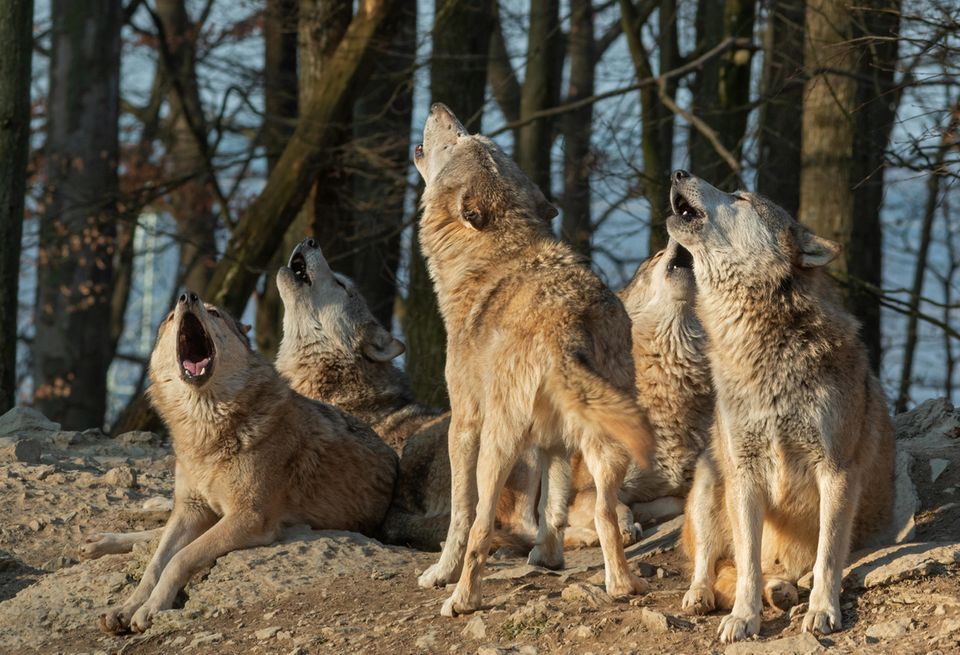in sight
Austria and Switzerland lower the shooting hurdle for wolves
Since the turn of the millennium, the wolf has been multiplying strongly again – in Austria, Switzerland and also in this country. The stock is now too large for many livestock owners, and they demand that the animal be allowed to be hunted.
© Jupiterimages
There is much debate about the life and death of wolves. He is legally protected, but the pressure to hunt him is growing. Austria and Switzerland have now made decisions.
“Act instead of watching”
There are also corresponding plans in Salzburg. “Act instead of watching” is the motto now, according to Upper Austria’s Minister of Agriculture, Michaela Langer-Weninger. In Switzerland, a new hunting ordinance will also come into force on July 1st. It contains, for example, changes for areas in which there was already damage: there, lone wolves can now be shot from six livestock tears, previously the threshold was ten tears. In addition, wolves are more likely to be killed if they appear near houses and are not afraid of people.
In addition, the Swiss government is providing another four million francs (4.1 million euros) for livestock protection. The animal protection organization Gruppe Wolf Schweiz attributes the fact that significantly fewer livestock were killed in the first half of 2023 to good herd protection. In Valais, the cracks decreased by 55 percent and in Graubünden by 80 percent compared to the same period last year. Most wolves live in the two cantons.
Wolves continue to multiply in Switzerland and Austria
According to the organization, there are 26 packs and about a dozen pairs of wolves in Switzerland. The inventory continues to grow. While in the first half of 2022 in Valais and Graubünden six wolves were released for shooting due to cracks, this year there was not a single one.
The lower hurdles for shooting down wolves in Austria violated EU law, said Lucas Ende from the Austrian Nature Conservation Union. The changeover of the official measures from a shooting decision to a regular ordinance has cut off the possibility of objections, for example by nature conservation associations. “At the national level, we no longer have any legal options to take action against a shooting,” said Ende.
Herd protection on alpine pastures probably does not work
The number of wolves in Austria has increased significantly to at least 40, said Albin Blaschka, head of the Austria Center Bär-Wolf-Luchs. In 2022 they would have killed around 800 sheep and goats on the alpine pastures. In this year’s alpine season there are about 150 so far. The experts currently counted seven packs and a number of roaming lone wolves.
“The kills in no way spare the herd protection,” said Blaschka. But that is precisely what is controversial. The state of Tyrol has declared all 2100 alpine pastures to be alpine protection areas and has classified herd protection as not feasible in the often steep terrain. Protecting the alpine pastures with fences is not an option for the state of Salzburg either: “Herd protection works in the area near the farm, the Salzburg farmers have already invested more than 800,000 euros for it,” said the wolf officer for the state of Salzburg, Hubert Stock. But high up in the terrain it looks different.
“The EU failed to adjust the protection status of the wolf”
Austria’s southernmost province of Carinthia is particularly active when it comes to wolf hunting. According to the state government, five animals classified as problematic have been shot here in the past year and a half. They had repeatedly approached settlements to less than 200 meters and could not be distressed, it was said.
There are currently seven packs and a number of roaming solitary wolves in Austria.
© Andyworks
Politicians from the conservative ÖVP and the right-wing FPÖ want to keep up the pressure on Brussels. “The EU failed to adjust the protection status of the wolf,” said Land Minister of Agriculture Langer-Weninger.
Among other things, the German Farmers’ Association is also striving for relief in the shooting of wolves in this country. The risk of wolf tears is particularly high on hillside pastures, which are typical of Bavaria and cannot be fenced in, it was said recently. For the year 2021, the association put the number of animals torn, injured or missing in this country at almost 3400.
Wolf is also spreading further in Germany
The wolf has been slowly spreading since its return to Germany in 1998. In the 2021/2022 wolf year (May 1 to April 30), the officially confirmed number of wolf packs nationwide was 161 (previous year 158), according to the Federal Agency for Nature Conservation (BfN) and the Federal Documentation and Advice Center on the subject of wolves (DBBW ) announced at the end of 2022.
For livestock keepers in Germany there are state subsidies for herd protection in almost all federal states with established wolf populations. About 1.20 meter high electric fences and – depending on the individual case – also herding dogs are recommended. The BfN advises that comprehensive herd protection should be carried out as preventively as possible before wolves get used to tearing sheep and goats, for example, as supposedly “easy prey”.



